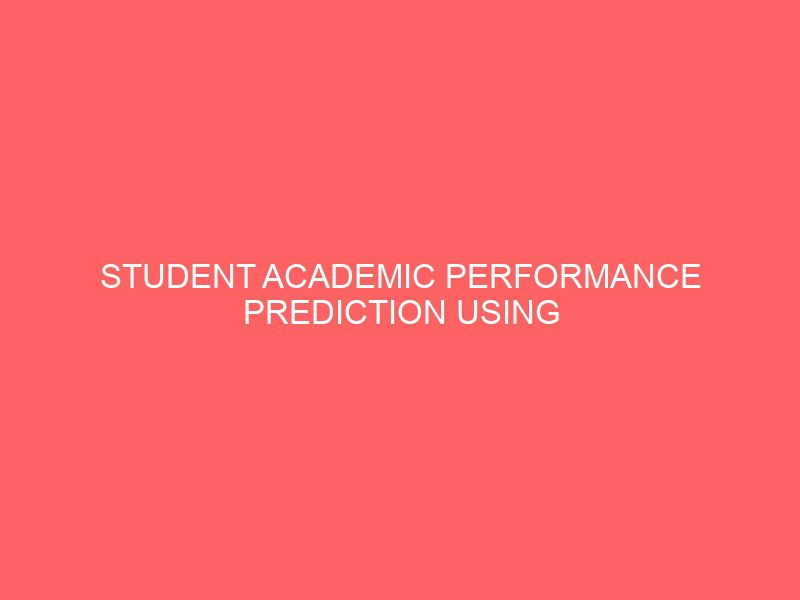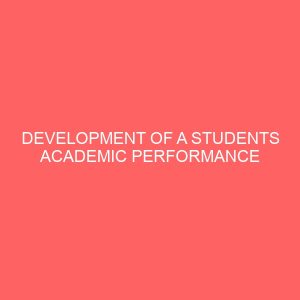Description
CHAPTER ONE
INTRODUCTION
1.1 Background of Study
(Sonja et al., 2014) Academic performance of students in recent years have constantly being dropping, this decline has greatly been affecting the standard of education and hence, recurrent poor academic performance of students have led to high failures or withdrawal rates in schools. Globalization and modernization have both brought about rapid technological changes in the society, especially as regards information and technology, with this, the advent of the internet and smart phones have also being a major source of student’s distraction in their academics, for instance most students spend more time with their phones chatting, watching movies, calling and playing games rather than spend more time with their books or use same phone to carry out academic research to better their grades. Academic education represents one of the key roles in the process of a country’s modernization and achieving competitive advantage, the process of educating and developing human resources is becoming an increasingly important concept, by which it can be a means of determining success in business and the society as a whole unit.
(Abimbola et al., 2018) With the threats of technological advancements in regards to how they distract students and the fact that students come from various backgrounds, certain factors have actively being influencing their lives and in-turn their academics, amongst this factor are; personality, culture, social-economic, psychological, academic, demography, psychosocial, cognitive to other environmental factors. There is a need for schools and most especially lectures to be able to understand their students through the use of predictive knowledge, and this forms the basis of this research.
The growth of student’s population especially in public schools, limits the level to which lecturers pay attention to their students, in other to understand their strengths and weaknesses, even with the rapid advancement in Information technology, managing and organizing students data, such as; enrolment data, academic data and so on, have continually being a problem to schools, with this problems, researchers have being trying to employ various branches of artificial intelligence such as data mining and machine learning techniques to be able to properly sort, arrange and output valid student details which can be used to understand what strategic approaches in teaching them can be adopted for optimum performance.
Predicting students’ performance using data mining methods has been performed at various levels such as: at a tutoring system level to predict whether some specific knowledge or skills are mastered, at job selection level to predict the students’ behavior in an educational environment and his/her career objective or placement performance (Sathick, 2013), at a course level or degree level to predict whether a student will pass a course or a degree, or to predict his/her marks (Asif, 2014).
The Applications of data mining techniques in the educational environments are more and more becoming popular, evident in the increasing number of research publications available (Wook et al., 2009). Researches in educational data mining area focus on different aspects of educational processes such as: students, teachers, teaching aids, organization of teaching and more (Falakmasir & Habibi, 2010). One of the main goals and the basic application field of educational data mining can be classified into the following categories: Prediction of students’ success, Organization of teaching programs, Prediction of enrolment of students to the higher level of educational program, Discovering cheating during an on-line examination, Identification of abnormal/extreme values in the educational system, (Kumar et al., 2011). In order to achieve these goals, different algorithms of data mining are used, such as: decision trees, artificial neural networks (ANNs), k-nearest neighbor, naive Bayes, support vector machines, cluster algorithms, (Ayesha et al., 2010).
Inspired by the structure of the brain, an Artificial Neural Network (ANN) consists of a set of highly interconnected entities, called Processing Elements (PE) or unit. Each unit is designed to mimic its biological counterpart, the neuron. Each accepts a weighted set of inputs and responds with an output. Neural Networks address problem that are often difficult for traditional computers to solve, such as speech and pattern recognition, weather forecasts, sales forecasts, scheduling of buses, power loading forecasts and early cancer detection. The origin of neural network can be traced to 1940s when two researchers, Warren McCulloch and Walter Pitts, tried to build a model to simulate how biological neurons work. Though the focus of this research was on the anatomy of the brain, it turns out that this model introduced a new approach for solving technical problem outside neurobiology. Neural networks have been applied in clustering, pattern recognition, function approximation and prediction systems. Several architectures for the ANN exist which include feed-forward, feed-backward, single-layer, recurrent, radial basis function network, and self-organizing maps (Usman, 2013).
In this research, artificial neural networks are used in order to make a system for early prediction of the success of students based on their success on the exams on the first year of studies. Early prediction of students’ success could help teachers to identify students that have potential for advanced courses and also students who need the additional education in order to improve their knowledge. On the other side, the development of the system will be useful for students, so that they could estimate their future success in their studies on the basis of their learning habits, their work and grades. This can help them to identify on time whether they need an additional effort in order to achieve the success they want.
1.2 Statement of the Problem
There is a need for lecturers and departments to be able to identify and understand what to expect from their students and how to adjust their teaching methods to enhance student understandings, the present academic system is such that with the large number of students, lecturers most times find it hard to understand their students and even do more in carrying those with academic deficiencies along. This has been a problem for so long and worst have led to students graduating with low grades.
With the proper implementation of an academic performance prediction system using neural network, it is believed that at an early stage in students academic pursuit, students with deficiencies such as those who have this natural fear for some courses can be easily identified and also lecturers too would be able to be more dedicated in their teaching strategy to help students with difficulties.
1.3 Aim and Objectives
The aim of this study is basically to develop and implement a student academic prediction system which will work with the use of neural networks.
The specific objectives are to:
- To determine some suitable factors that affect student’s performance.
- To transform these factors into forms suitable for an adaptive system coding.
- To model an Artificial neural network that can be used to predict a candidate’s performance based on some given data for a given student.
1.4 Scope of the study
This project is purposely designed to focus on providing a means through which students academic performance can be easily predicted, to guide steps to be taken to improve their grades.
1.5 Limitation of the study
Limitations to this research were basically Time and access to educational resources from past research conducted in relation to this study.
1.6 Definition of Terms
Prediction: A statement about what you think will happen in the future.
Neural Network: A computer system modelled on the human brain and nervous system.
Academic Performance: Refers to the achievements or failures or students in their studies.
Artificial Neural Network: An artificial neuron network (ANN) is a computational model based on the structure and functions of biological neural networks.
Computer based system: Is an organized integration of hardware and software technologies and human elements designed to produce timely, integrated, accurate and useful information for decision making purposes.
Computer Program: Is a collection of instructions that performs a specific task when executed by a computer.








Reviews
There are no reviews yet.